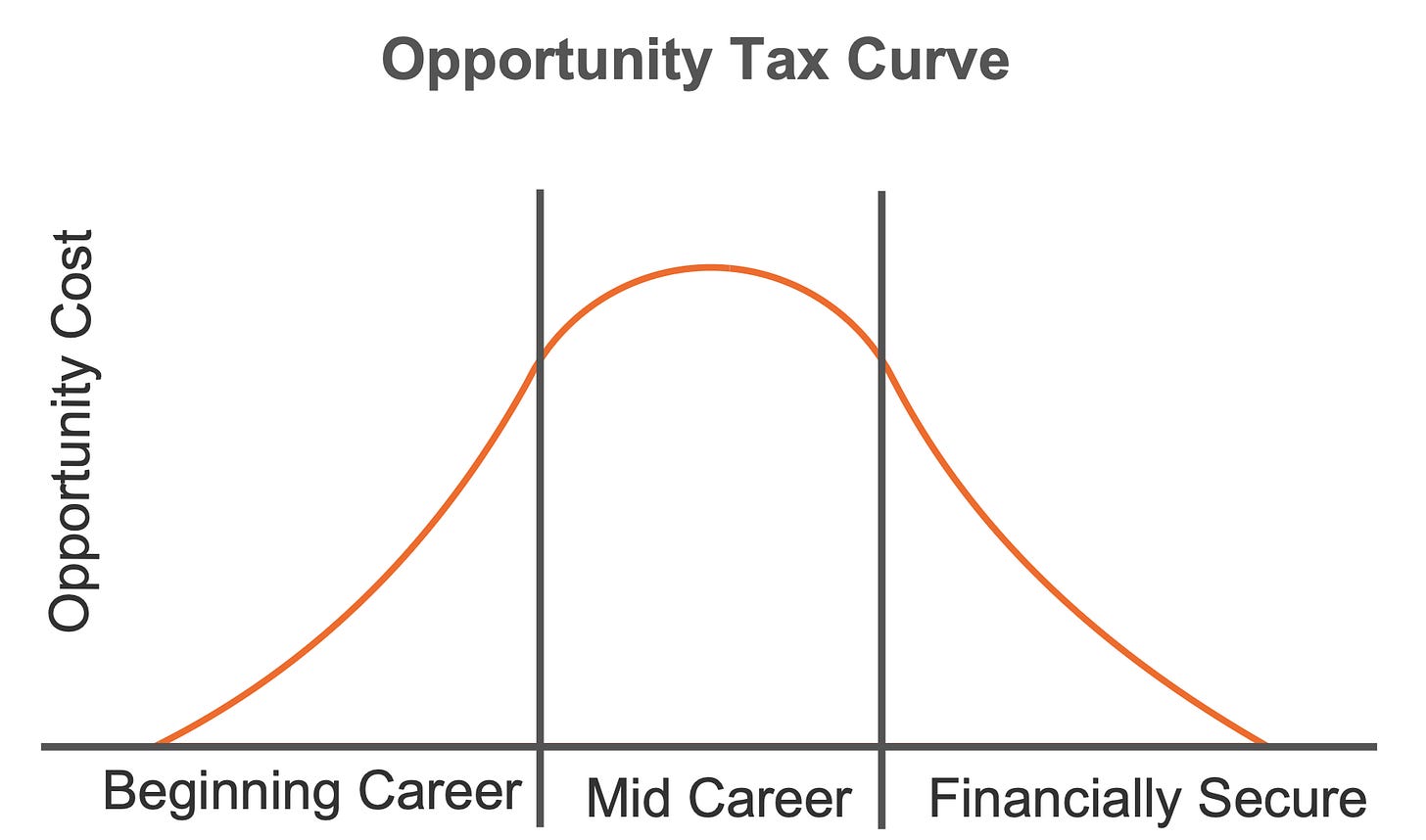The Opportunity Tax
Why Getting Older Means Getting Wiser About Risk
Life is a series of trade-offs. Every “yes” is simultaneously a “no” to something else. This is the essence of opportunity cost – the invisible tax we pay on every decision. After years in the military, tech, entrepreneurship, and academia, I’ve felt this tax in more ways than one. Sometimes, it’s cost me a lot of money. Sometimes, it’s cost me years of effort.
The Young Person’s Advantage
When you’re young, opportunity cost is almost a cheat code. You can afford to fail spectacularly, to bet the farm on your YouTube career instead of taking that consulting job. Why? Because time is on your side. The cost of failure, your opportunity tax, is relatively low. You’ve got decades to recover, pivot, and try again.
But here’s the rub: this advantage has an expiration date.
The Age Tax Spike
As you get older, the opportunity tax spikes. Each failed venture isn’t just about lost money, it’s about lost time. And you can’t get that back. That’s why you won’t see many 50-year-olds quitting their jobs to become a TikTok influencer. It’s not because they couldn’t succeed. It’s because the opportunity cost is too damn high.
Let me give you an example from my own life.
The Third Coast Grappling Story: A Lesson in Timing
In 2017, my business partner, Ryan McGuire, and I saw a gap in the jiu-jitsu market. Most promotions treated it like a commodity, pack in the athletes, sell some tickets, rinse, and repeat. We had a different vision: bring UFC-level production value to a niche sport and make it entertaining and sexy.
We were right about the opportunity. We set new standards. We made noise. Our streaming partner, Flo Grappling, liked our ideas so much that they… checks notes… started their own promotion. They also sued us for a million dollars, but that’s a story for another day.
Then COVID hit.
We pivoted and created a tournament-style event called “The Kumite” (yes, like the underground fighting tournament from Bloodsport, sometimes life imitates art). We were one of the first sports promotions back in action during the pandemic. But the economics didn’t work. Athletes needed guaranteed money, and the model broke.
The opportunity was real, but the timing was off. That’s the thing about opportunity cost, it’s not just about whether you’re right, but whether you’re right at the right time.
The Joy Factor
Here’s the kicker, none of this matters if you don’t love what you’re doing. We only get 4 to 5 career cycles in life. Wasting one on something you hate is the highest opportunity cost of all.
If you’re stuck in a role you don’t love, find the parts you enjoy. If marketing excites you, spend time with the marketing team. Pitch ideas. Build relationships. Create your own opportunity within the constraints you have.
The Opportunity Algorithm
So, how do you evaluate opportunities? Here’s my framework:
Good Opportunity = (Insight × Timing × Passion) ÷ Risk
Risk, in this case, is a function of causes and consequences. It’s like a house fire risk, you need prevention (reduce likelihood) and mitigation (reduce impact). Maybe you won’t install a sprinkler system (too expensive), but you’ll buy insurance (reasonable cost, high impact mitigation).
This structured approach to evaluating risk and opportunity draws inspiration from Ray Dalio’s book Principles, which advocates breaking decisions down to assess immediate and long-term consequences. Dalio’s framework reinforces the importance of calculating risks intelligently, especially as the consequences of a wrong decision grow larger with age.
The Bottom Line
As I sit here, with my role at Apple and teaching at UT, I’m much slower to jump at new opportunities. The opportunity tax is higher now. Any new venture would need to offer returns so compelling that they justify the opportunity cost of leaving roles I genuinely love.
That’s the wisdom that comes with age, not that we become more risk-averse but more risk-intelligent. We learn to calculate the opportunity tax before we pay it.
The key is understanding where you are on the opportunity cost curve, young or old. The younger you are, the more you can afford to ignore it. The older you get, the more you need to respect it. When you are financially secure, you can maybe go back to afford to ignore it again, as long as you are financially responsible.
But here’s the most important thing: the biggest opportunity cost of all is never taking any risks at all. It’s just math.
Don’t get captured,
Connect with Zach
Provide Feedback
Also, Check out the Prof Z Project Library, where I have added many resources (books, tools, articles, and podcast recommendations) for different topics such as entrepreneurship, leadership, operations, finance, personal development, real estate, and even health and fitness. It's a free resource, so enjoy a single location for useful things I have found. Send me a message with any suggestions to add to the library.




